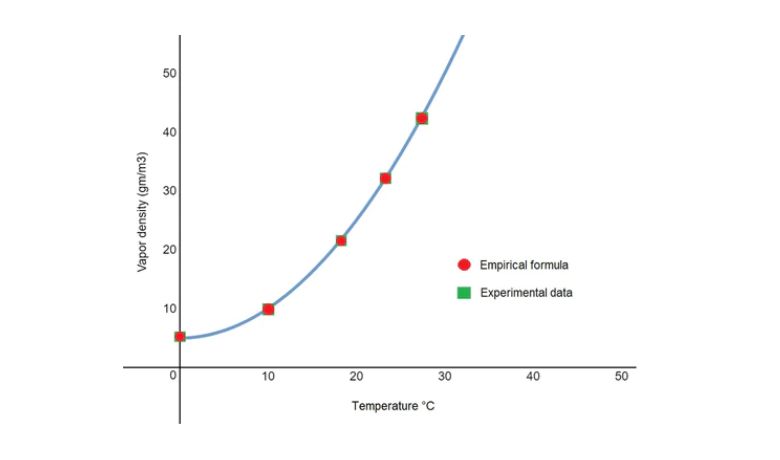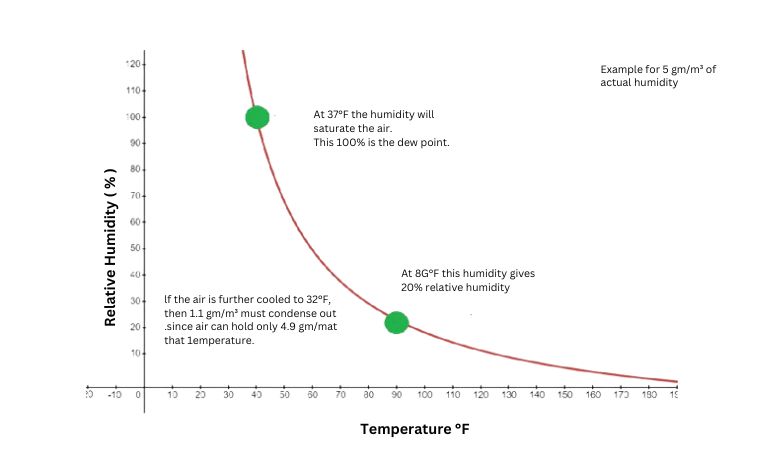Relative humidity (RH) isn’t how much moisture is in the air, but rather how much it can hold compared to its current temperature. Think of it like a sponge – warm air, like a bigger sponge, can hold more moisture than cool air. This is why the same amount of moisture can feel muggy on a hot day and dry on a cool day.
Here’s why RH is important:
* Weather:
High RH can lead to clouds and rain. It also affects how much heat the air holds, impacting weather patterns.
* Daily Feel:
High RH makes hot days feel hotter and cold days colder by affecting sweat evaporation and how our bodies perceive temperature.
* Indoor Comfort:
Proper indoor RH prevents issues like mold or dry skin and creates a more comfortable living space.
Some Key Concepts
What is Relative Humidity? Relative humidity definition
Relative humidity (RH) isn’t a direct measure of how much moisture is in the air. Instead, it tells you the percentage of moisture the air currently holds compared to the maximum amount it could hold at a specific temperature. Imagine a sponge – warm air, like a bigger sponge, can hold more water vapor than cool air. So, the same amount of moisture can result in a high RH in cool air and a low RH in warm air.
RH=100×PwsPw
Significance of Relative Humidity
Understanding RH is crucial for:
- Weather patterns: High RH indicates a greater chance of cloud formation and precipitation. It also affects how much heat the air can hold, which influences weather systems.
- Indoor comfort: Maintaining a proper indoor RH level helps prevent problems like mold growth in high humidity or dry skin in low humidity. It also impacts how comfortable we feel by affecting sweat evaporation.
Absolute vs. Specific Humidity
- Absolute Humidity: This is the actual amount of water vapor present in a certain volume of air, usually expressed in grams per cubic meter (g/m³). It’s like the total amount of water the sponge is holding, regardless of its size.
- Specific Humidity: This is the ratio of the mass of water vapor to the total mass of moist air (including both water vapor and dry air). Think of it as the concentration of water vapor in the air, similar to how salt concentration is measured in water.
These concepts relate to RH because absolute humidity tells you the total moisture, while RH considers how much more the air could hold at its current temperature. Specific humidity provides another way to express moisture content relative to the total air mass.

Temperature and Dew Point
Temperature plays a critical role in determining RH. Warmer air can hold more moisture, so the same amount of water vapor will result in a lower RH at higher temperatures.
Dew Point: This is the temperature at which the air must cool for its water vapor to condense into liquid water, like dew or fog. It’s a key factor because when the air temperature cools to the dew point, the RH reaches 100%.

Saturation and 100% Relative Humidity
When the RH reaches 100%, the air is saturated. This means it’s holding the maximum amount of moisture it can at its current temperature. Any additional moisture will condense into liquid water, leading to:
- Rain: If the rising air cools further, condensed water droplets become too heavy and fall as rain.
- Fog: When near the ground, condensed water droplets form fog, reducing visibility.
- Dew: On cool surfaces at night, condensed water droplets form as dew.
Calculating Relative Humidity
There are a few ways to calculate relative humidity (RH), depending on the information you have available. Here’s a breakdown of the most common methods:
1. Basic Formula and Components
The most common formula for RH is:
RH = (e / e_s) x 100
Where:
- RH: Relative Humidity (percentage)
- e: Actual vapor pressure in the air (units vary)
- e_s: Saturation vapor pressure – the maximum amount of vapor the air can hold at its current temperature (same units as e)
2. From Absolute Humidity
If you have the absolute humidity (AH) value (e.g., grams per cubic meter), you can estimate e using conversion tables or online calculators that account for temperature. Then, you can plug both values into the basic formula to find RH.
3. With Temperature and Dew Point
This method is often more convenient as dew point is readily available from weather reports or measured with a hygrometer. Here’s how to calculate RH with temperature (T) and dew point (Td) in degrees Celsius:
- Convert Temperatures (if needed): If your temperature readings are in Fahrenheit, convert them to Celsius by subtracting 32 and multiplying by 5/9.
- Use the Following Formula:
RH = 100 x exp[17.625 x Td / (243.04 + Td)] / exp[17.625 x T / (243.04 + T)]
Explanation:
- exp stands for the mathematical exponent function (available on most calculators).
- Td and T are the dew point and temperature values in Celsius, respectively.
Tools and Calculators
While the above formulas can be used for manual calculations, several online calculators and apps simplify the process. These tools often allow you to input various values (temperature, dew point, or absolute humidity) and calculate the corresponding RH. Remember to check the unit system (Celsius or Fahrenheit) used by the calculator to ensure accurate results.
Practical Applications and Examples
Example Calculations
Let’s use the formula with temperature and dew point (Td in °C) to calculate RH in different scenarios:
1. Hot and Humid Day: Temperature (T) = 30°C, Dew Point (Td) = 22°C
RH = 100 x exp[17.625 x 22 / (243.04 + 22)] / exp[17.625 x 30 / (243.04 + 30)] = 68%
2. Cool and Dry Day: Temperature (T) = 15°C, Dew Point (Td) = 5°C
RH = 100 x exp[17.625 x 5 / (243.04 + 5)] / exp[17.625 x 15 / (243.04 + 15)] = 42%
These examples show how a higher dew point relative to the temperature indicates higher relative humidity.
Measuring Relative Humidity in Practice
We can’t directly sense humidity, so we rely on instruments like:
1. Hygrometers: These instruments measure the amount of moisture in the air and display the corresponding RH. There are various types, including electronic hygrometers with digital displays and mechanical hygrometers that use hair or other materials that expand or contract with changes in humidity.
Applications: Hygrometers are used in homes, greenhouses, weather stations, and various industries to monitor and control humidity levels.
2. Psychrometers: These instruments use two thermometers, one with a wet wick. By measuring the difference in temperature between the dry and wet thermometers, psychrometers can determine the relative humidity.
Applications: While less common than hygrometers, psychrometers are sometimes used in professional settings for more precise humidity measurements.
By understanding how to calculate and measure relative humidity, you can gain valuable insights into the moisture content of the air, impacting everything from weather forecasting to creating a comfortable indoor environment.
Understanding the Impact of Relative Humidity
Relative humidity (RH) plays a significant role in our world, influencing both weather patterns and our comfort indoors.
Effects on Weather and Climate
- Cloud Formation and Precipitation: High RH is a key factor in cloud formation. As warm, moist air rises and cools, water vapor condenses into tiny droplets or ice crystals, forming clouds. When enough condensation occurs, these droplets or crystals become too heavy and fall as rain, snow, or other forms of precipitation.
- Severe Weather: High humidity can contribute to the formation of severe weather events like thunderstorms. Warm, humid air is more buoyant and can rise rapidly, creating powerful updrafts that fuel storm development.
- Climate Patterns: Changes in regional humidity levels can influence global climate patterns. For example, areas with high and persistent humidity can trap heat, contributing to rising temperatures.
Indoor Air Quality and Comfort
- Thermal Comfort: RH significantly impacts how we perceive temperature. High humidity makes hot days feel hotter by hindering sweat evaporation, our body’s natural cooling mechanism. Conversely, low humidity can make cool days feel colder.
- Respiratory Health: Proper indoor humidity levels can help prevent respiratory problems. Very dry air (low RH) can irritate airways and exacerbate allergies or asthma. Conversely, excessively high humidity (above 60%) can promote mold growth, which can trigger allergies and respiratory issues.
Ideal Levels of Relative Humidity
The ideal RH range for indoor comfort and health is generally considered to be between 30% and 50%. Here’s a breakdown of ideal levels for different environments:
- Homes and Offices: A range of 30-50% RH is recommended for comfort and to prevent mold growth.
- Bedrooms: Slightly lower RH (around 30-40%) might be preferable for sleep comfort, especially in warmer climates.
- Storage Areas: Lower RH (around 30-40%) is ideal to prevent mold growth on stored items.
Maintaining proper indoor humidity can be achieved through various methods, such as ventilation, dehumidifiers, and humidifiers. By understanding the impact of RH, we can create a more comfortable and healthy indoor environment.
FAQs
1: How do I calculate relative humidity with temperature and dew point?
You can calculate relative humidity (RH) using the following formula with temperature (T) and dew point (Td) in degrees Celsius:
RH = 100 x exp[17.625 x Td / (243.04 + Td)] / exp[17.625 x T / (243.04 + T)]
- exp stands for the mathematical exponent function (available on most calculators).
Remember:
- If your temperature readings are in Fahrenheit, convert them to Celsius before using the formula.
- Many online calculators and apps can simplify the calculation process by taking temperature and dew point as inputs and providing the corresponding RH.
2: What does it mean when relative humidity is 100%?
A relative humidity of 100% indicates that the air is saturated. This means it’s holding the maximum amount of moisture it can at its current temperature. Any additional moisture will condense into a liquid state, leading to phenomena like:
- Rain: If the rising air cools further, condensed water droplets become too heavy and fall as rain.
- Fog: When near the ground, condensed water droplets form fog, reducing visibility.
- Dew: On cool surfaces at night, condensed water droplets form as dew.
3: What happens to relative humidity when the temperature increases?
When the temperature increases, relative humidity (RH) actually decreases. Here’s why:
Imagine a sponge. Warm air acts like a bigger sponge; it can hold more moisture compared to cool air, which is like a smaller sponge.
- Scenario 1: Cool Air (Small Sponge)
Let’s say you have a small amount of water (representing moisture) in the cool air (small sponge). Since the cool air can’t hold much moisture, this translates to a high relative humidity because the air is close to its capacity.
- Scenario 2: Warm Air (Big Sponge)
Now, if the temperature increases (the sponge gets bigger), the same amount of moisture can occupy a larger space within the air. This means the air is further away from its saturation point, resulting in a lower relative humidity.
In essence, the total moisture content might stay the same, but the proportion of moisture the air can hold increases with rising temperature. This change is reflected in a decrease in relative humidity.






